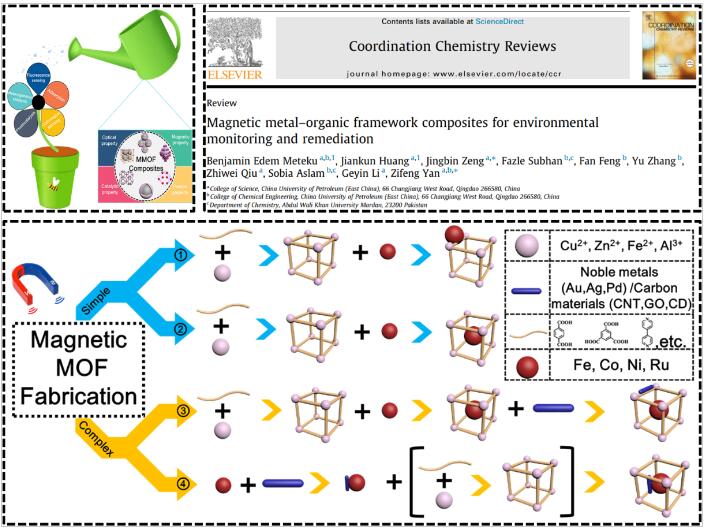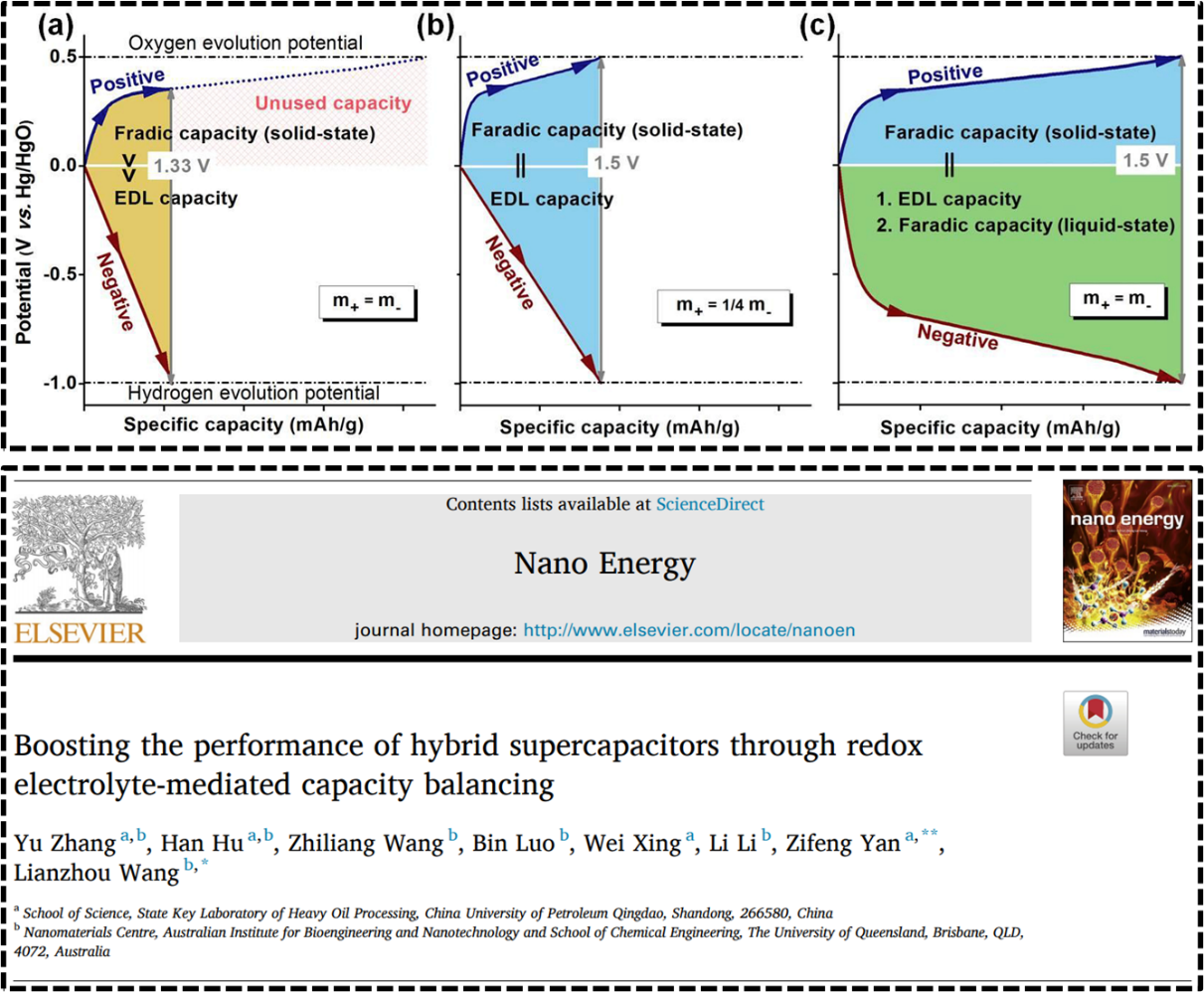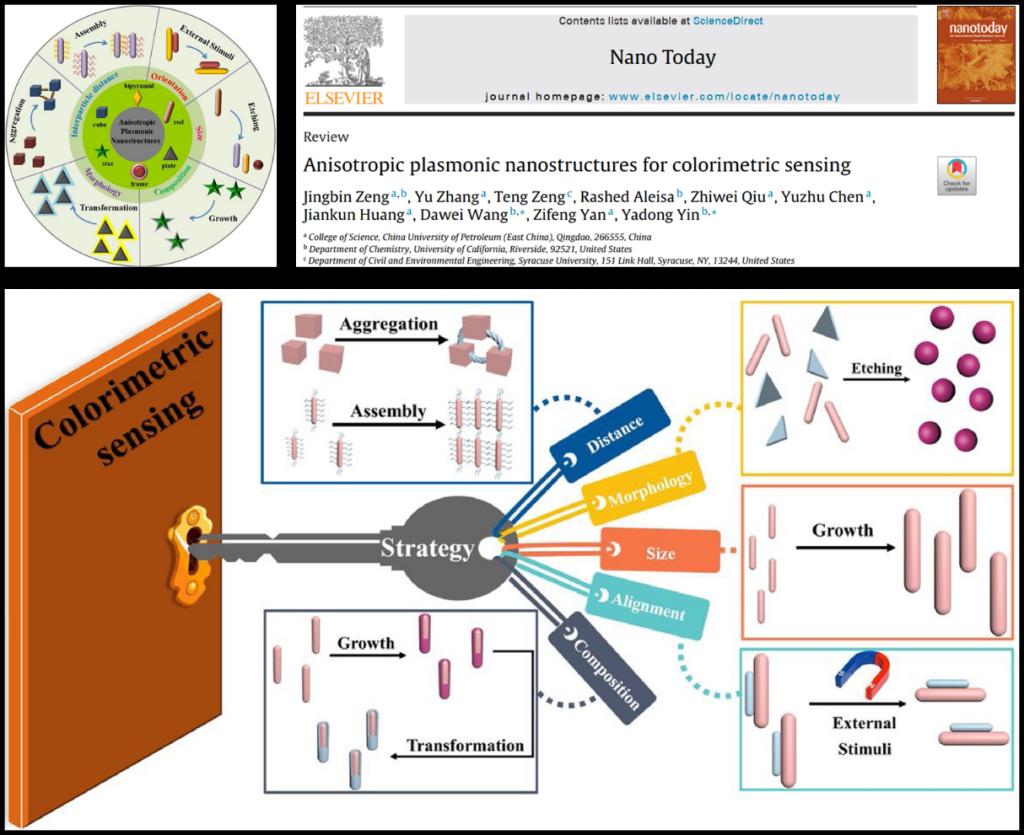In recent times, micro- and nano-structured functional materials have gained great attention due to their intrinsic properties. These features make them highly suitable candidates for energy-related, catalytic as well as environmental applications. Currently, different approaches have been used to obtain structural design of micro- and nano-materials for novel functionalities and applications. However, structural features are yet to be satisfied due to precise synthesis and saleable fabrication are always mutually exclusive. Recently, in a series of new articles in the Coordination Chemistry Review,Nano Energy,Nano Today,ACS Applied Materials & Interfaces, Nanoscale. The catalysis and material research group headed by Prof. YAN Zifeng from China University of Petroleum (UPC) got inspired to solve this issue from interfacial/surficial structural design and multi-scale fabrication.
A review article titled “Magnetic metal-organic framework (MMOF) composites for environmental monitoring and remediation” was published in Coordination Chemistry Reviews (DOI information: 10.1016/j.ccr.2020.213261). Based on former research work (Energy & Environmental Science, 2018, 11(9): 2341-2347.; Nano-micro letters, 2018, 10(1): 4. Analytical Chemistry, 2019, 91(8): 5091-5097. Chemical Engineering Journal, 2017, 330: 372-382;), Benjamin Edem Meteku and Jiankun Huang as the first authors, highlighted the general methods for synthesizing MMOF composites and the classification of MMOF composites based on their composition with appropriate examples. In-depth analysis of physicochemical properties of MMOF composites that are harnessed for the detection and remediation of environmental contaminants and are discussed. Furthermore, the practical applications of these auspicious composites to detect some environmental pollutants and remediate their effects on the environment are extensively explored. Finally, the new frontiers and prospects of MMOF composites in global environmental pollution mitigation is presented. This work was financially supported by the National Key Technologies R&D Program of China, Key projects of intergovernmental international innovation cooperation and the Shandong Key Research and Development Project of China.

An internationally cooperative research article titled “Boosting the performance of hybrid supercapacitors through redox electrolyte-mediated capacity balancing” was published in Nano Energy (DOI information: 10.1016/j.nanoen.2019.104226). Zhang Yu as the first author proposed a new concept of asymmetric electrolyte design in the HSCs where NiCo layered double hydroxide (LDH) battery-type electrode operates in the KOH electrolyte while electrolyte-soluble redox couples are deliberately introduced to the carbon capacitive electrode. The redox couples contribute extra faradic capacity to the capacitive carbon electrode, resolving the capacity imbalance problem in the two electrodes with equal mass loading. The optimized HSC delivers extraordinarily high specific energy of 79.6 Wh/kg, which is about 4 times the value in the pristine unbalanced device (20.3 Wh/kg). This new conceptual design could be extended to other energy storage systems to further improve performance. This work was financially supported by the financial support from China Scholarship Council.

A review article titled “Anisotropic plasmonic nanostructures for colorimetric sensing” was published in Nano Today (DOI information: 10.1016/j.nantod.2020.100855). Based on the former research work, (Nano letters, 2019, 19(5): 3011-3018; Advanced Functional Materials, 2018, 28(26): 1800515; ACS Appl. Mater. Interfaces, 2017, 9, 9416-9425; Sensors and Actuators B: Chemical, 2016, 228,366-372; Chem. Commun., 2014, 50, 8121-23; Nanoscale, 2014, 6, 9939-43), Prof. Zeng JingBin as the first author discussed the colorimetric detection involving anisotropic nanostructures such as nanorods, nanoplates, nanoflowers, nanobipyramids, nanoframes, and nanocubes, which exhibit many unique advantages compared to their isotropic counterparts. In addition to illustrating the design principles, sensing mechanisms, and applications of these anisotropic nanostructures-based colorimetric methods, the writers also discuss smart plasmonic sensors based on anisotropic nanomaterials that are used to detect external stimuli such as temperature, pH, light, magnetic field, and mechanical force. This work was financially supported by the National Natural Science Foundation of China and the Fundamental Research Funds for the Central Universities.

Two research articles titled “Biomimetic Fabrication of Highly Ordered Laminae-trestle-laminae Structured Copper Aero-sponge” and “Multi-arches Structured All-carbon Aerogels with Super Elasticity and High Fatigue Resistance as Wearable Sensors” were published in ACS Applied Materials & Interfaces (DOI information: 10.1016/j.nanoen.2019.104226) and Nanoscale (DOI information: 10.1039/C9NR10593J), respectively. Jiankun Huang as the first author poured the solution or put the hydrogel into an open-ended cylinder mould placed on a cold copper platform and frozen in one direction at a constant freezing rate. The aero-sponges/-gels were obtained from freeze-drying and annealing. The proposed unidirectional freeze-casting method are advantageous for processing low-dimensional nanomaterials into various polymeric and carbon aero-materials. This method makes aero-materials fabrication on the large scale. This work was financially supported by the National Key Technologies R&D Program of China, Key projects of intergovernmental international innovation cooperation, the Shandong Key Research and Development Project of China and postgraduate innovation project.

Over the past years, the research team led by Prof.Yan Zifeng proposed a series of conceptual designs and surficial/interfacial methods for the fabrication of micro- and nano-structured functional materials. The works provide important and instructive concepts for developing high-performance micro- and nano-structured functional materials.
Author:HUANG Jiankun , ZHANG Yu
Updated: 2020-03-19